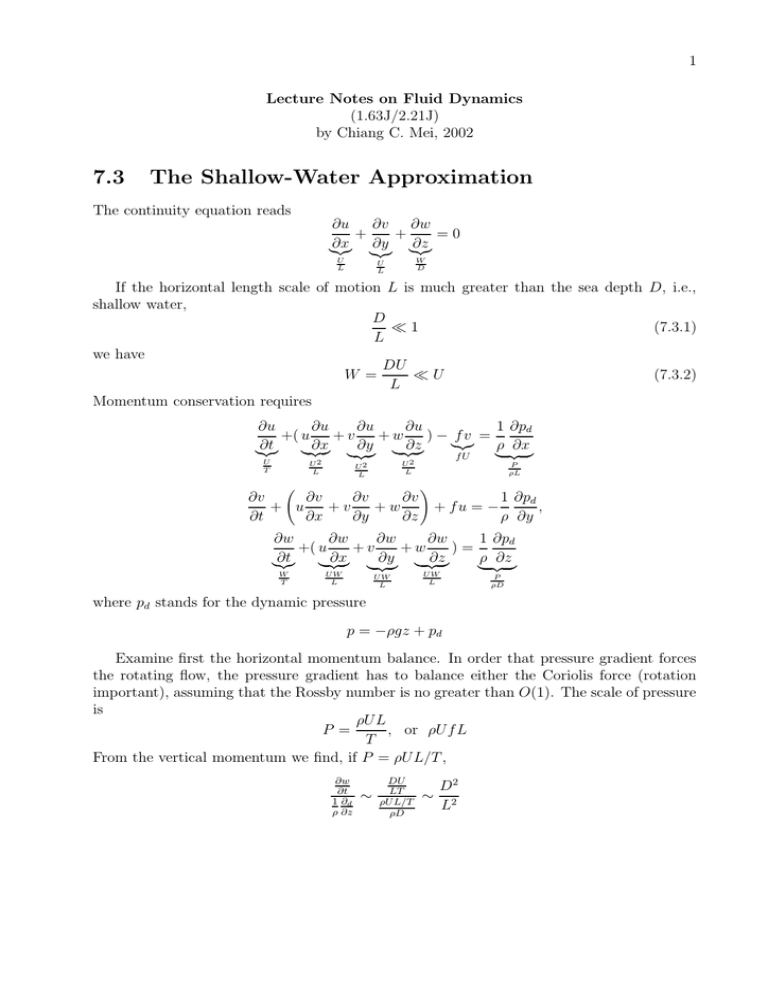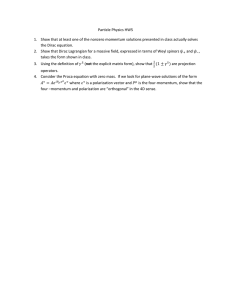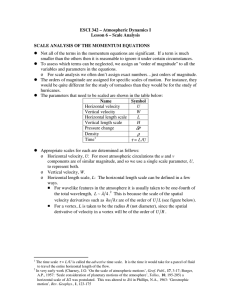7.3 The Shallow-Water Approximation
advertisement

1
Lecture Notes on Fluid Dynamics
(1.63J/2.21J)
by Chiang C. Mei, 2002
7.3
The Shallow-Water Approximation
The continuity equation reads
∂u ∂v ∂w
+
=0
+
∂x
∂y |{z}
∂z
|{z}
|{z}
U
L
W
D
U
L
If the horizontal length scale of motion L is much greater than the sea depth D, i.e.,
shallow water,
D
1
(7.3.1)
L
we have
DU
W =
U
(7.3.2)
L
Momentum conservation requires
∂u
∂u
∂u
∂u
1 ∂pd
+( u + v
) − fv =
+w
|{z}
∂t
∂x}
∂y | {z
∂z}
ρ ∂x
|{z}
| {z
| {z }
U2
L
U
T
fU
U2
L
U2
L
∂v
∂v
∂v
∂v
+ u
+v
+w
∂t
∂x
∂y
∂z
| {z }
P
ρL
!
+ fu = −
1 ∂pd
,
ρ ∂y
∂w
∂w
∂w
∂w
1 ∂pd
+( u
+v
+w
)=
∂t
∂x}
∂y | {z
∂z}
ρ ∂z
|{z}
| {z
W
T
UW
L
| {z }
UW
L
where pd stands for the dynamic pressure
| {z }
UW
L
P
ρD
p = −ρgz + pd
Examine first the horizontal momentum balance. In order that pressure gradient forces
the rotating flow, the pressure gradient has to balance either the Coriolis force (rotation
important), assuming that the Rossby number is no greater than O(1). The scale of pressure
is
ρU L
P =
, or ρU f L
T
From the vertical momentum we find, if P = ρU L/T ,
∂w
∂t
1 ∂d
ρ ∂z
∼
DU
LT
ρU L/T
ρD
∼
D2
L2
2
and if P = ρU f L,
∂w
∂t
1 ∂d
ρ ∂z
∼
DU
LT
UfL
ρD
∼
D2 1
L2 T f
Since the time scale of interest is of a day or so, f T = O(1). We conclude that the vertical
pressure gradient is practially zero with error of order D 2 /L2 1, implying that
pd ' ρgη
(7.3.3)
ptotal ' ρg(η − z)
(7.3.4)
or the total pressure is hydrostatic
Thus,
∂pd
∂η
= ρg
∂x
∂x
∂pd
∂η
= ρg
∂y
∂y
(7.3.5)
We now show by a formal perturbation scheme for horizontal bottom, that u, v are
independent of z to the leading order or approximation,
∂u ∂v ∂w
+
+
=0
∂x ∂y
∂z
(7.3.6)
∂u
∂u
∂u
∂u
∂η
+u
+v
+w
− f v = −g
∂t
∂x
∂y
∂z
∂x
(7.3.7)
∂v
∂v
∂v
∂v
∂η
+u
+v
+w
+ f u = −g
∂t
∂x
∂y
∂z
∂y
(7.3.8)
w=0
(7.3.9)
On the bottom
On the free surface
∂η
∂η
∂η
+u
+v
= w,
∂t
∂x
∂y
z=η
(7.3.10)
Assuming the following expansions:
u = u0 +
z+h
(z + h)2
u1 +
u2 + · · ·
L
2L2
(7.3.11)
v = v0 +
z+h
(z + h)2
v1 +
v2 + · · ·
L
2L2
(7.3.12)
w=
z+h
(z + h)2
w1 +
w2 + · · ·
L
2L2
(7.3.13)
3
where un , vn , wn are independent of z. From the x momentum equation we get from (7.3.7)
∂u0
∂u0
∂η
∂u0
+ u0
+ v0
− f v0 + g
∂t
∂x
∂y
∂x
!
∂u0
∂u1
∂u0
∂u1 w1 u1
(z + h) ∂u1
+
+ u1
+ u0
+ v1
+ v0
+
− f v1
L
∂t
∂x
∂x
∂y
∂y
L
z+h
+
L
!2
(· · ·) + · · · = 0
(7.3.14)
with a similar equation for the y momentum. Separating the zeroth power of (z + h)/L we
get
∂u0
∂u0
∂u0
∂η
+ u0
+ v0
− f v0 = −g
(7.3.15)
∂t
∂x
∂y
∂x
∂v0
∂v0
∂η
∂v0
+ u0
+ v0 )
+ f u0 = −g
(7.3.16)
∂t
∂x
∂y
∂y
Thus u, v are depth-independent to the leading order. Also from continuity,
∂u0 ∂v0 w1
+
+
=0
∂x
∂y
L
and from the free surface condition
∂η
∂η
η+h
+ u0
=
w1
∂t
∂x
L
Hence after eliminating w1 ,
∂η ∂[(η + h)u0 ] ∂[(η + h)v0 ]
+
+
=0
∂t
∂x
∂y
(7.3.17)
(7.3.18)
(7.3.19)
In summary, for shallow seas,
∂u
∂u
∂u
∂η
+u
+v
− f v = −g
∂t
∂x
∂y
∂x
(7.3.20)
∂v
∂v
∂v
∂η
+u
+v
+ f u = −g
∂t
∂x
∂y
∂y
(7.3.21)
to leading order.
If Rossby number is small, then the convective inertia is negligible; the momentum equations reduce to :
∂u
∂η
− f v = −g
(7.3.22)
∂t
∂x
∂v
∂η
+ f u = −g
(7.3.23)
∂t
∂y
where are linear.
Take for estimates, U = 0.1, 1m/s, Ω = 2.31 × 10−5 , L = 100, 1000km = 105 , 106 m,
Rossby number U/2ΩL = 0.043. We leave it as an exercise to work out the equations for
h(x, y) with a small slope.
4
7.3.1
Geostrophic motion
For steady flow at small Rossby number,
H =η+h'h
the momentum equations reduce to
∂η
∂x
∂η
f u = −g .
∂y
−f v = −g
Thus, Coriolis force and pressure gradient are in balance
u=−
implying
u
g ∂η
f ∂y
v=
g ∂η
f ∂x
∂η
∂η
+v
=0
∂x
∂y
(7.3.24)
or
~q · ∇η = 0.
Physically along a streamlines, the free surface height remains constant. Hence, the surface contours are parallel to the streamlines and to isobars. This state is called geostrophic.
7.3.2
Remark: Depth-integrated mass conservation
The depth integrated mass conservation (7.3.25) is a general an exact result which holds for
variable depth as well. On the seabed z = −h(x, y), vanishing of the normal veocity requires
w = −u
∂h
∂h
−v .
∂x
∂y
On the free surface z = η(x, y, t), the kinematic boundary condition reads,
w=
∂η
∂η
∂η
+u
+v
∂t
∂x
∂y
z=η
Integrating the continuity equation and using Leibniz’s rule
Z
!
∂u ∂v ∂w
0 =
+
+
dz
∂y
∂z
−h ∂x
Z
Z
∂ η
∂ η
η
= [w]−h +
udz +
vdz
∂x −h
∂y −h
∂η
∂η
∂h
∂h
+ u(η) +
v(η) −
u(−h) −
v(−h).
∂x
∂y
∂x
∂y
η
5
Define the total depth to be H = η + h
∂η
∂η
0= w−u
−v
∂x
∂y
!
∂h
∂h
− w+u
+v
∂x
∂x
η
!
+
−h
∂Hu ∂(Hv)
+
∂x
∂y
Using the boundary conditions we get
∂H ∂Hu ∂Hv
+
+
= 0.
∂t
∂x
∂y
(7.3.25)







